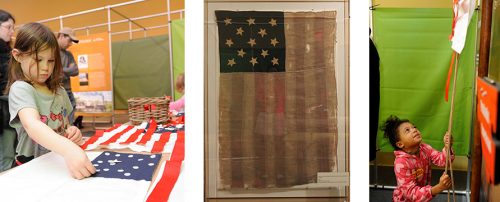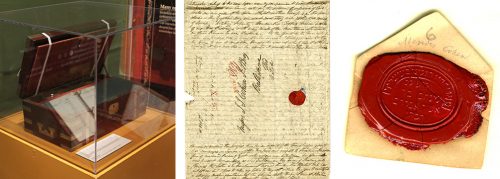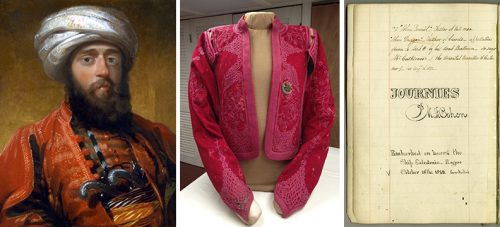Travel with the A-Mazing Mendes Cohen

While the museum is closed the JMM team is coming together to bring some of our favorite activities from our recent family programs direct to your homes. Each collection of materials will be inspired by either one of our exhibits, Jewish History, or a Jewish holiday. All of the activities we share will be designed for families to complete together and only require supplies you are likely to already have in your home. The activities we offer will be varied from crafts, activities, games, scavenger hunts, and online story times. You can check out previous activity packs here!
~The JMM Programs Team
(left) Portrait of Mendes Cohen wearing a turban and ceremonial jacket, c.1835. Courtesy of the Maryland Historical Society. (center) The ceremonial jacket Mendes purchased during his travels. Gift of Mary Adair Dockery (University Collection, Johns Hopkins University), 1996.169.1. (right) title page of Mendes’ travel journal, 18729. Courtesy of the Maryland Historical Society.Mendes Cohen had numerous fascinating phases to his life, one of which was the time he spent in travelling the world. For almost three years he travelled much of Europe, northern Africa and the Middle East. If you have a look here you can see Mendes’ travel log.
Travel at this time was much more complicated than it is today. It took Mendes nearly three weeks to make the crossing from New York to Liverpool, England! During his three years of travel, Mendes would encounter multiple shipwrecks, revolts and narrowly avoid bandits.
While the exhibit was on view here at the Jewish Museum of Maryland, we celebrated this phase of Mendes’ life with various family programs. Below are a few of our favorite activities you can enjoy at home and will give you a better sense of this time of his life.
Make sure to share photos of you enjoying our crafts and activities on our Facebook, Twitter, Instagram, or Tumblr pages and use #MuseumFromHome and #AmazingMendes!
Download the full Travel with the A-Mazing Mendes Cohen activity packet as a single pdf here.
Magical Shabtis

Mendes spent about four months in Egypt, during which time he began to collect antiquities, items that dated to Ancient Egypt. The items he gathered varied from tiny amulets to statues and even mummies. In total, Mendes collected almost 700 items! The collection he amassed was donated after his death, becoming one of the founding collections of the Johns Hopkins Archaeological Museum.
From Mendes’ travel journal: Thebes, Egypt, June 26 and 27, 1832
“Remained aboard all day to purchase antiquities, which were brought down, having passed around the tombs occupied by the gatherers of these things. When my guide made proclamation that I should be in my boat 2 days for the purpose of buying antiquities, after which I should depart. At this time many of the people brought out things, of which I bought a few. Ibis were in peak abundance. Crockery, vases, figures, mummies, snakes, crocodiles, dogs, sheep heads, etc.”
“Remained on board, many little things were brought down, from which I made a small collection. Purchased two mummies and after spending the evening at Mr. Hay’s and taking leave, returned on board at midnight when the two mummies had been brought.”
Shabti dolls (also known as shawbti and ushabti) were funerary figures in ancient Egypt who accompanied the deceased to the after-life. Learn more about shabtis here.
Shabtis form a huge part of the collection that Mendes gathered. These small figurines are one of the most common items in museum Ancient Egyptian collections. This is because they were produced in huge quantities out of sturdy materials, which helped them survive intact through the ages.
In this activity you can try your hand at designing your own shabtis.
What you will need:
Print out of the shabti template or paper
Pencil and markers
Download Instructions for Designing a Shabti
Flying the Flag

One of our favorite artifacts in The Amazing Mendes Cohen exhibit was an American flag that Mendes flew as he sailed down the Nile. Mendes made this flag himself (with the help of a servant)!
From Mendes’ travel journal: Manfalut, Egypt – May 3, 1832
“Purchased red, white and blue cotton to make a flag – returned on board and cut it out, my servant making it” … “Having … completed the flag and hoisted it under a salute, each of the sailors… on the elevation of the flag agree to defend it if necessary.”
Showing his patriotism and pride in America was important to Mendes, even while traveling. In this journal entry, Mendes’ shares how important celebrating Independence Day was to him.
From Mendes’ travel journal: Sarmastar, Egypt – July 4, 1832
“I have not forgotten that this is the anniversary of our independence and although remote from my country where I can well imagine the festivities all going on in all parts of the union, yet on this day is doubly valuable having seen so much of the despotism of Europe and Asia. At break of day, 4 o’clock a.m., I fired a salute, which at this early hour amazed the Arab sailors not a little, who were yet asleep on the deck. At sunrise hoisted the national flag and continued floating down the Nile against a very strong headwind.”
In this activity you can create your own Star-Spangled Banner – as you do, think about what the flag means to you.
Learn more about the history of the Star-Spangled Banner in this online exhibit from the National Museum of American History. You can also explore many resources online with The Star-Spangled Banner Flag House, home and workshop of Mary Pickersgill, who sewed the actual flag that inspired Francis Scott Key’s writing of our national anthem.
What you will need:
Paper, ideally red white and blue
Glue or tape
Paint stirrer
Scissors
Download Instructions for Making The Flag
Letters Home

Mendes relied upon letters to stay in contact with his family. They could take weeks to arrive but when they did they delivered exciting news from his adventures abroad. One item Mendes carried throughout his travels was his beautiful travel writing desk, filled with paper, ink, and his personal wax seal.
In this activity, learn about the importance of his seal and how to make your own. You can learn more about the history and importance of seals here.
Try reading one of Mendes’ letters here. To maximize space, Mendes has written very small and between the lines – it can be very challenging to decipher, especially with our modern eyes! But reading his letters yourself can give you great insight into Mendes and his travels.
Why not write a letter of your own? Share what you’ve been up to with friends or family you are missing – you can even use your new seal to add an extra special element to your letter.
What you will need:
Clay or model magic
Tools for scraping, cutting, and shaping your seal material
Download Instructions for Making Your Own Seal

